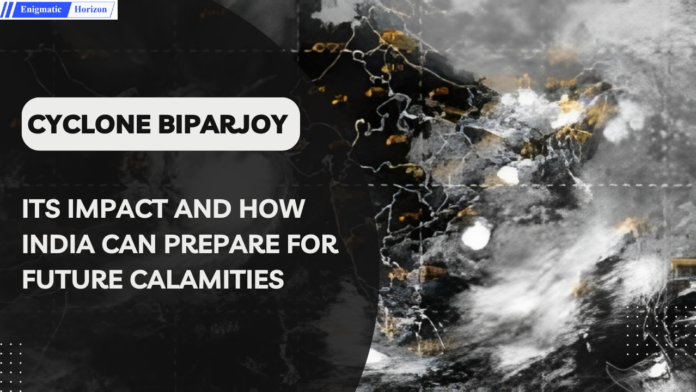Arnabjyoti Kashyap
The cyclone Biparjoy, located in the Arabian Sea, has caused heavy rains, strong winds, and tragic incidents across the south-western coastline of India. It was positioned in the afternoon of Thursday, June 8, about 900 kilometers southwest of Mumbai and 850 kilometers west of Goa. The cyclone intensified by June 13, becoming a very severe cyclonic storm during the next three days.
The name of the cyclone was proposed by Bangladesh as “Biparjoy,” which is Bengali for “disaster” or “calamity.”
The India Meteorological Department (IMD) first noticed a depression on June 6 before it developed into this cyclonic storm. Deep flaring convection caused the cyclone to gradually lose strength. Biparjoy strengthened to a Category 3-equivalent tropical cyclone and an extremely dangerous cyclonic storm as it moved faster northeast. According to reports received from the Indian Meteorological Department (IMD), the cyclone caused squally weather with wind speeds reaching 35-45 kmph along the coastlines of Karnataka, Goa, and Maharashtra.
The arrival of the cyclone has also kept the monsoon somewhat muted. According to the IMD, the monsoon arrived in Kerala on Thursday, eight days later than usual, but the cyclone impeded its northward advance across the interior of the mainland.
Impact of Cyclone Biparjoy
India, Oman, Iran, and Pakistan are among the nations that border the Arabian Sea that the IMD has not yet forecast experienced a significant impact due to this cyclone.
In India, heavy rains and strong winds struck Gujarat’s coastal regions, killing three people in the districts of Kutch and Rajkot. A wall collapsed and trees were uprooted as a result of the bad weather. Tents situated on Mandvi Beach were also swept away by strong waves in Kutch. The Dwarka area experienced high tides as the cyclone neared the coast. Heavy rains and tall tidal waves were also experienced in the neighboring state of Maharashtra. Near Mumbai’s Juhu district, the bodies of four boys who had vanished after swimming in the Arabian Sea were found. There were a total of 23 injuries, and 4,600 villages experienced power outages.
Preparation for future calamities like Biparjoy
In India, preparing for natural disasters such as cyclones necessitates a multifaceted approach involving a wide range of stakeholders, including government agencies, community organizations, and individuals. Some of the steps that can be taken are as follows:
- The government must develop and strengthen early warning systems to detect cyclones in advance. This involves meteorological agencies monitoring weather patterns, issuing timely warnings, and disseminating information through various channels like TV, radio, mobile alerts, and social media.
- The government must also identify high-risk areas prone to cyclones and develop evacuation plans accordingly. Establish designated cyclone shelters or safe zones for people to seek refuge during the cyclone. Ensure these shelters have basic amenities such as food, water, medical supplies, and sanitation facilities.
- There should be awareness campaigns conducted to educate the public about cyclone preparedness, including understanding warning signals, evacuation procedures, and essential supplies to have on hand. This can be done through community meetings, school programs, mass media, and social media platforms.
- The people must strengthen critical infrastructure to withstand cyclones. This includes constructing cyclone-resistant buildings, reinforcing power distribution systems, improving drainage systems to prevent flooding, and securing communication networks for efficient coordination during emergencies.
- The people must train and equip emergency response teams, including medical personnel, firefighters, and disaster management authorities, to handle cyclone-related emergencies. Conduct regular drills and simulations to enhance their readiness and coordination.
- The people should also develop comprehensive plans for post-cyclone relief and rehabilitation efforts. Ensure the availability of emergency supplies like food, clean water, medicines, and temporary shelter.
- The government should encourage local communities to form volunteer groups, task forces, or neighborhood committees responsible for disseminating information, assisting in evacuation, and supporting relief operations.
Above all, we must remember that cyclone preparedness is an ongoing process, and regular evaluation and updating of plans based on lessons learned from past events are crucial. It is also important to stay informed through official sources, follow instructions from local authorities, and be prepared to take immediate action when a cyclone is approaching.
